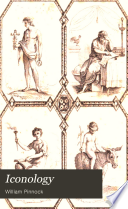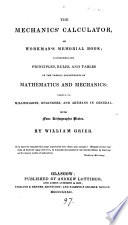 | 1829 - 522 pages
...instruments or elements of which every machine, however complicated, must l>e constructed : they aro the Lever, the Wheel and Axle, the Pulley, the Inclined Plane, the Wedge, and the Screw. MELTING POINT. That point of the thermometer which indicates the heat at which any particular solid... | |
 | Jeremiah Joyce - Science - 1829 - 278 pages
...were in vain to expect you to comprehend the principles of mechanics. There are six mechanical powers. The lever ; the wheel and axle ; the pulley ; the inclined plane ; the wedge; and the screw. Emma. Why are they called mechanical powers? ,« Father. Because, by their means we are enabled mechanically... | |
 | 1829 - 460 pages
...Former Annuals, contains, by Tables and Easy Rules, free from Algebraic Formula:, the Calculations of the Lever, the Wheel and Axle, the Pulley, the inclined Plane, the Wedge and the Screw, the Gravitating Property of Bodies, the Centres of Gravity, Gyration, and Percussion, the Vibrations... | |
 | Samuel Greatheed, Daniel Parken, Theophilus Williams, Josiah Conder, Thomas Price, Jonathan Edwards Ryland, Edwin Paxton Hood - English literature - 1829 - 592 pages
...Author briefly describes the nature and properties of the six mechanical powers, — the lever, the K wheel and axle, the pulley, the inclined plane, the wedge, and the screw, and then their simple combinations. In proceeding to illustrate the practical application of these... | |
 | Luke Herbert - Industrial arts - 1829 - 394 pages
...iNTUODtTCTIOy. THE elements of machinery are, by writers on mechanics, generally itivided into six kinds ; viz. the lever, the wheel and axle, the pulley, the inclined plane, the screw, and the wedge. There seems, however, to be one or two other ways of generating mechanical efficacy,... | |
 | Luke Hebert - 1829 - 392 pages
...BTUoN. Tn» elttnonts of machinery are, by writers on mechanics, generally tiivVded into six fcintU ; viz. the lever, the wheel and axle, the pulley, the inclined plane, the screvr, and the wedge. There seems, however, to be one or two other ways of generating mechanical efficacy,... | |
 | William Pinnock - Emblems - 1830 - 520 pages
...which are certain instruments employed for supporting weights, and giving motion to bodies, are six, viz. the lever, the wheel and axle, the pulley, the inclined plane, the wedge, and the screw : all the latter, however, are but different modifications of the lever. * BALUEC, anciently called... | |
 | William Pinnock - Emblems - 1830 - 576 pages
...which are certain instruments employed for supporting weights, and giving motion to bodies, are six, viz. the lever, the wheel and axle, the pulley, the inclined plane, the wedge, and the screw : all the latter, however, are but different modifications of the lever. * BALBEC, anciently called... | |
 | John Bonnycastle - Measurement - 1833 - 310 pages
...simple of mechanical applications to increase force and overcome resistance. They are usually accounted six in number, viz. The Lever — The Wheel and Axle—...The Inclined Plane — The Wedge — and the Screw. LEVER. To make the principle easily understood, we must suppose the lever an inflexible rod without... | |
 | William Grier - Mechanical engineering - 1832 - 366 pages
...other. 2. The simple machines, or those of which all others are constructed, are usually reckoned six: the lever, the wheel and axle, the pulley, the inclined plane, the wedge, and the screw. To these the funicular machine is sometimes added. THE LEVER. 4. A lever is an inflexible bar, either... | |
| |